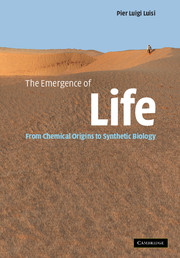Book contents
- Frontmatter
- Contents
- Preface
- Acknowledgments
- List of books on the origin of life
- 1 Conceptual framework of research on the origin of life on Earth
- 2 Approaches to the definitions of life
- 3 Selection in prebiotic chemistry: why this … and not that?
- 4 The bottle neck: macromolecular sequences
- 5 Self-organization
- 6 The notion of emergence
- 7 Self-replication and self-reproduction
- 8 Autopoiesis: the logic of cellular life
- 9 Compartments
- 10 Reactivity and transformation of vesicles
- 11 Approaches to the minimal cell
- Outlook
- References
- Index
3 - Selection in prebiotic chemistry: why this … and not that?
Published online by Cambridge University Press: 17 December 2010
- Frontmatter
- Contents
- Preface
- Acknowledgments
- List of books on the origin of life
- 1 Conceptual framework of research on the origin of life on Earth
- 2 Approaches to the definitions of life
- 3 Selection in prebiotic chemistry: why this … and not that?
- 4 The bottle neck: macromolecular sequences
- 5 Self-organization
- 6 The notion of emergence
- 7 Self-replication and self-reproduction
- 8 Autopoiesis: the logic of cellular life
- 9 Compartments
- 10 Reactivity and transformation of vesicles
- 11 Approaches to the minimal cell
- Outlook
- References
- Index
Summary
… l'uovo cadde dal ciel
e come a Dio piacque
l'uovo si ruppe
e la gallina nacque.
(Tuscan folkloric poetry)Introduction
Having considered in the previous chapters the “software” of the origin of life, we are now ready to look at the “hardware” – some chemistry facts. Let us start from the beginning.
A way to connect software and hardware is summarized in Figure 3.1, which shows the most common beliefs and assumptions of researchers in the field. Particularly important is the assumption that some form of minimal life can be made in the laboratory, once the right conditions of prebiotic chemistry are found.
Life on Earth may have started between 3.5 and 3.9 billion years ago, as shown in Figure 3.1. The oldest microfossils were described by J. W. Schopf from the Apex Chert at Marble Bar, Western Australia (Schopf, 1992, 1993, 1998). These are dated at 3.465 Ga. Microfossils from Swaziland (South Africa) are of similar age. The North American Gunflint Chert (2 Ga) and the Belcher Group microfossils from Canada are the first occurrence of the Precambrian.
Schopf's data have been criticized (Brasier et al., 2002) and the controversy is still open. However, most scientists accept the idea that micro-organisms already existed about 3.4–3.5 billion years ago.
If these fossils were cells with an already fully fledged genome, then the origin of life must be placed earlier – and by so doing we come very close in geological time to the formation of the first cold rocks.
Information
- Type
- Chapter
- Information
- The Emergence of LifeFrom Chemical Origins to Synthetic Biology, pp. 38 - 58Publisher: Cambridge University PressPrint publication year: 2006
